Startup blast
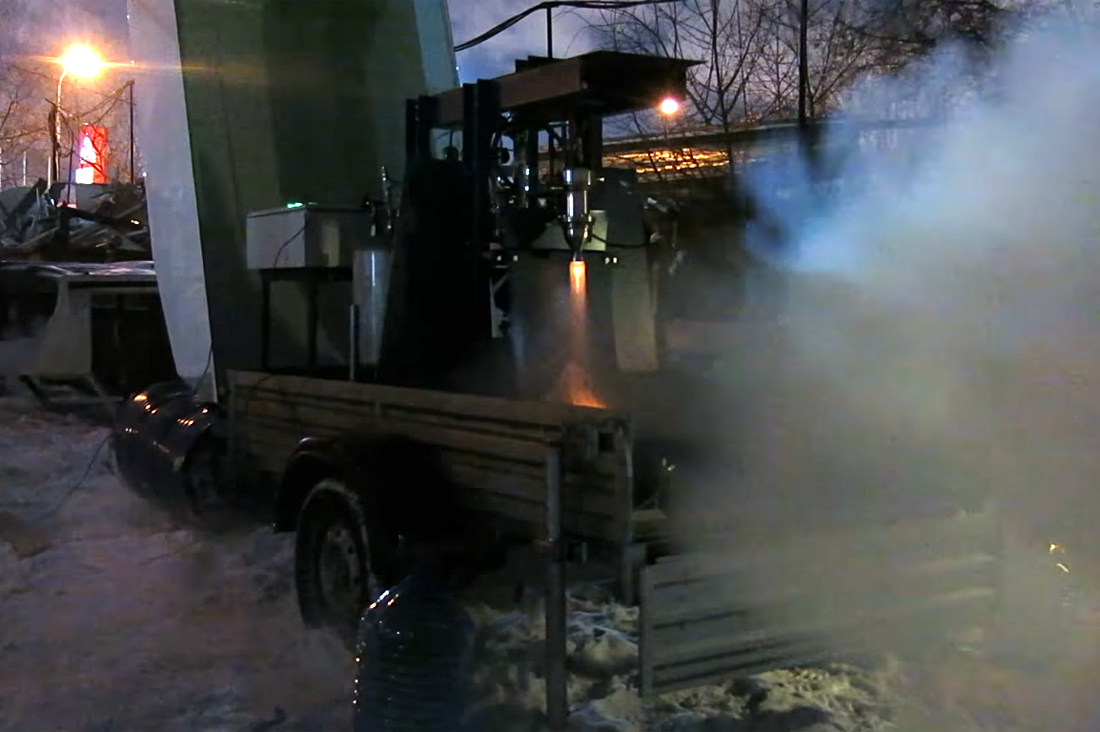
On the 44th anniversary of the last step of a man across the Moon, an explosion thundered in the Moscow industrial zone, which marked a new level of private rocket production in Russia. A private company and a Skolkovo startup “Lin Industrial” switched to firing tests of its first liquid-propellant rocket engine. The tests ended in an explosion from which the uncomplicated person suffered.
The company "Lin Industrial" appeared in mid-2014. Created by real astronautics enthusiasts who were inspired by the success of Western private traders and decided to enter the nascent market of micro-rocket launches. Now in the world there are many small and large private projects that create rockets for launching micro-and nano-satellites into near-earth orbit. “Lin Industrial” was the first and, in fact, the only such private initiative in Russia. Like any decent startup, Lin has a maximum program: a plan to build a moon base , Luna Seven .

')
The general designer of the company, the initiator and ideological mastermind is known to many as the LiveJournal blogger ___lin___ , and Alexander Ilyin , editor of the magazine Cosmonautics News. His engineering and space education helped to write about space, but at some point he could not stand it and took up his own project. As for the economic prospects of micro-missiles, I would argue with him, but in the end, we need to start with something. Someone builds microsatellites, someone microracket.

“Lin” became a resident of the Skolkovo Foundation, and moved along the difficult and thorny path of obtaining a Skolkovo micro-grant in the amount of 5 million rubles. On the way, he was lucky: he found a private investor, though not from Russia, but from neighboring Belarus. Co-founder of the company Wargaming Sergey Burkatovsky, and a longtime acquaintance, invested several million rubles into Alexander's initiative. To create the first micro-rocket, according to Ilyin's calculations, at least 500 million rubles are required, but the first investments allowed starting practical activities.
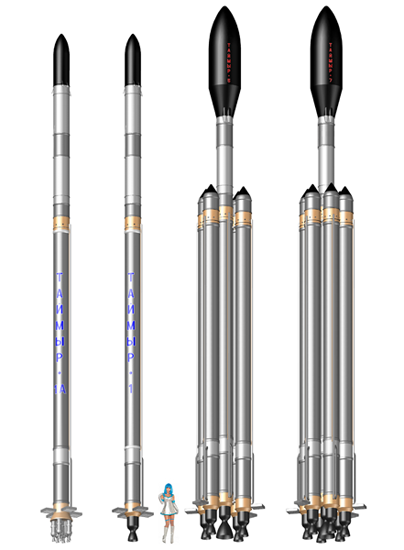
The main development was called “Taimyr”. This should be a modular three-stage rocket, which, depending on the number of lateral accelerators, could bring into low earth orbit from 10 to 150 kg of cargo, at a price of $ 15-20 thousand. This is an approximate cost per kg of launch to the Space Shuttle, but cheaper than $ 40 thousand from the competing RocketLab. Microracket is more expensive than modern passing launches on conventional Soyuz or Falcon-9 missiles, but their prospects are in the convenience of choosing orbits and launch dates, and in this field active competition is expected in the future.
An innovation in the rocket was the selected fuel: liquid vapor, hydrogen peroxide and kerosene. I think the mention of hydrogen peroxide made those who were slightly interested in the history of technology in the 20th century startled. This component of the fuel, wherever they tried to use, and almost always it ended in explosions, victims and catastrophes. The last major victim of peroxide is the Kursk submarine. But the engineers of “Lina” are familiar with the history, so they decided to use a concentration of peroxide not higher than 85% - this promised low danger and rather high characteristics of the rocket. The reason for this choice is also constructive, usually for the oxidation of kerosene in rockets, liquid oxygen is used, but it is a cryogenic component that requires serious refueling infrastructure and metal missile tanks. To reduce the weight and reduce the cost of construction of the rocket, the engineers decided to stop at the composite tanks.

In the development of “Taimyr”, the simplest stage seemed to be the creation of an electronic missile control system. To this end, "Lin" began to launch essentially amateur rockets to a height of several hundred meters, while trying to equip them with aerodynamic control surfaces and control the flight.
For these launches used solid fuel engines.
Some progress in this was, after some time the rockets became bigger and more complicated. It came to supersonic launches and two-stage “flying stands”.
At the same time, “Lin”, as a Skolkovsky startup, often glowed at various technological exhibitions with its plastic space rocket (not to scale) and metal prototypes of its development rocket engines.
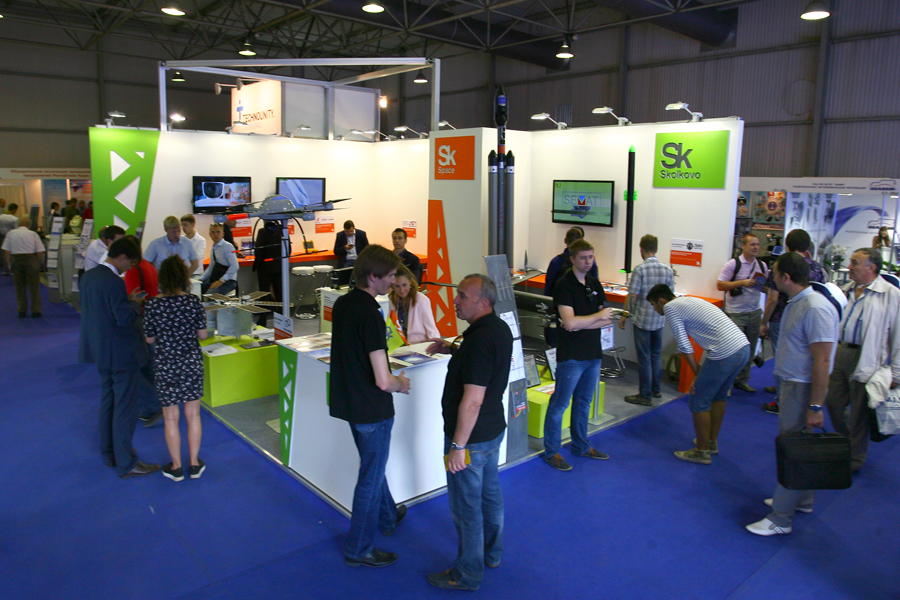
But behind the amateur launches of plastic “caramel” rockets, the exhibition picture, photo shoots and public relations in the media there were a lot of difficulties that startups were not keen on space. All of more than two years, until today, have passed for “Linov” in the mode of overcoming. Alexander in his blog and pages of social networks picturesquely talked about constantly falling problems that no one expected.
The company faced endless bureaucratic obstacles in obtaining a license for space activities. That is, the company is still not legally space. In fact, since 2012, when “Sputnik” and “Dauria Aerospace” received this status, not a single private trader in Russia who dreams of becoming a space has received the coveted license.
Tests of his first Atar-100 liquid-propellant rocket engine “ Lin Industrial” planned to be carried out at the test stand of the Moscow Aviation Institute . When the engine was ready, MAI withdrew its consent without giving reasons, and hinting at its fears for the safety of the stand.

She agreed to help with the tests of one of the enterprises in the space industry, but then also changed her mind.
At the same time, great difficulties arose with the search for a testing ground for amateur “Rocket Fest” . In the eyes of Alexander Ilyin, everything looked like a conspiracy directed specifically against his startup. Who benefits from his failure? Is Roskosmos afraid of a young ambitious competitor and intrigues?
I must say that the image of a noble fighter with circumstances, Alexander Ilyin would gladly take over, but not everything is so simple. Many representatives of the industry on the part of Roskosmos noted his arrogance and arrogance, so even if they did not consciously put sticks in their wheels, they were not eager to help.
One way or another, “Lin” had to start making his own test bench . For small rocket engines there is not such a large-scale structure, the production of which for the enterprises of Roscosmos is generally child's play, but for a small startup it was a significant expense and loss of time.

By the fall of 2016, the developers began a so-called. “Pouring tests” when ordinary distilled water is spilled through the engine and fuel systems. This allows you to check the readiness of the fuel lines, valves, pumps. The next stage is firing.
Of course, the enthusiastic engineers, who for two and a half years went to their rocket, could not wait to see the first flame more quickly. None of them wanted to spend time in endless approvals of field tests, and previous experience showed that there could be no such agreement at all. They explained the refusal of the option “go to an open field”: “it is winter now, and the stand is assembled on the basis of an ordinary car trailer, which has a very mediocre passability”.

The reasons for the rush, of course, not only in the desire to quickly bang, but also financially trite: the investment is running out every day, you need to show results and progress in order to count on the next round. I suspect that reporting in Skolkovo required tests to close the stage.
As a result, they took advantage of the offer of a friend who knew a comfortable wasteland in the industrial zone. It seemed that at 12 o'clock in the morning, in a 15-degree frost, on Sunday there were certainly no strangers in the warehouse of ferrous metal scrap. The participants in the tests themselves hid behind an old truck and felt safe. From the remote control they gave the start command ...
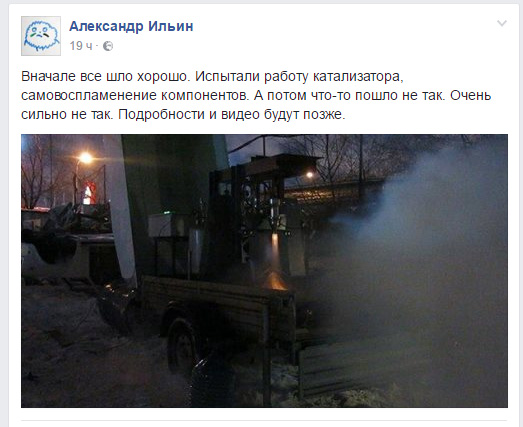
What happened then is not exactly known. According to media reports, during the explosion of the engine, one of the metal fragments flew 20 meters, struck a galvanized iron fence, a change house wall in the adjacent area and seriously damaged the wrist joint of a worker there. The severity of the damage has not been established. “MK” reported an open fracture, LIFE wrote all day about the amputated limb. According to Lina, the damage is severe, the tendons are affected, but the arm is in a cast and in place.
The founders of the company have already declared their willingness to reimburse the cost of treatment and pay monetary compensation, but no one has yet received the comments of the victim himself. In addition, the Ministry of Internal Affairs has not yet decided what to do with the young and not very followers of Ilona Mask and Sergey Korolev, while with them they took only obligations to help the investigation.
Obviously, "Lin" got carried away and lost the sense of danger, without which it is impossible to work with rocket technology. But despite the safety violations, the serious injury of a person, and the failure of tests, the future of Lin Industrial has not yet been determined. Someone wants the company a speedy termination of existence. Although I would remind the story of the appearance of one of the strongest divisions of NASA, Jet Propulsion Laboratory, recounted in “Martianin”: “The students staged an explosion at a hostel, but they were not punished, but given a test base and ordered to continue.” And the history of the Royal GIRD is not very different: there were also garages, vacant lots, and explosions of experimental engines, which in thirty years led to the flight of Gagarin.
I think Roskosmos would easily have found a safe platform for testing not only Ilyin, but also all private owners, students and enthusiasts who dream of space and want to do something with their own hands.
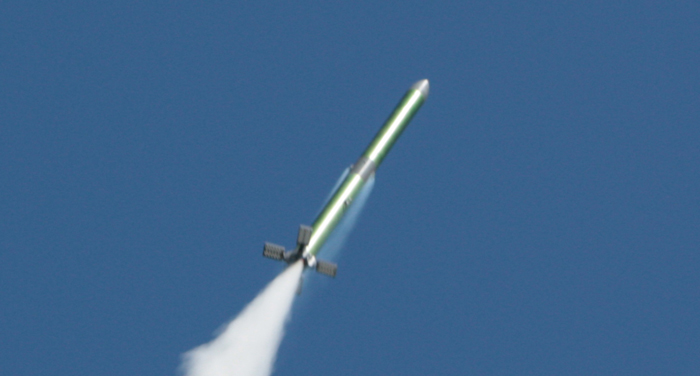
Those who wish to support "Lin Industrial" can look into their store and purchase one of the products. Subscribe to their Facebook page or Vkontakte to follow the news.
Source: https://habr.com/ru/post/399895/
All Articles